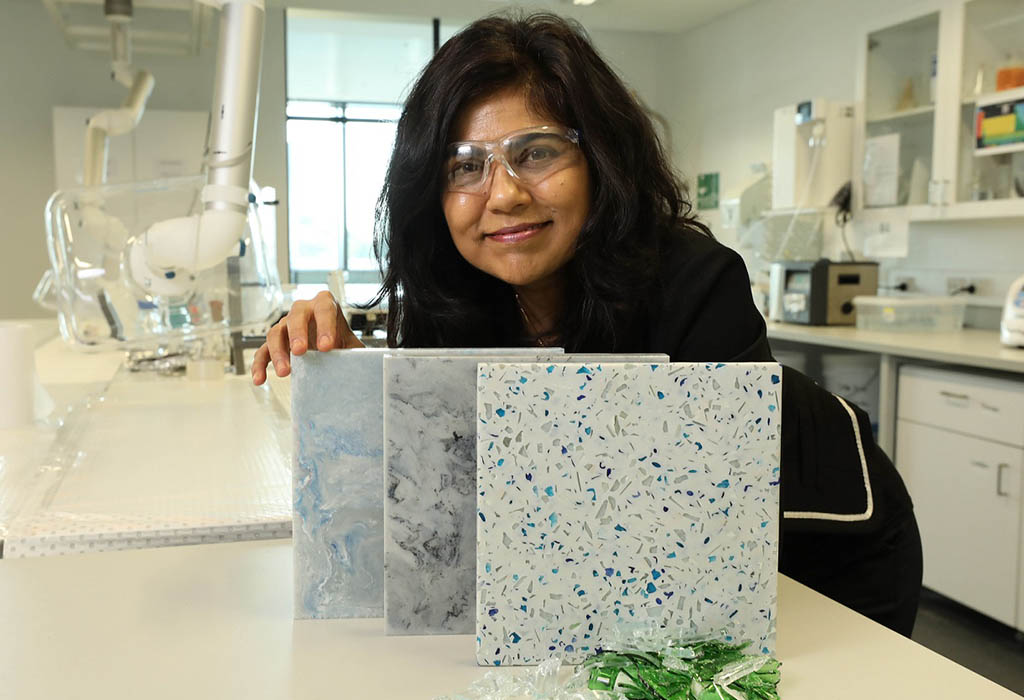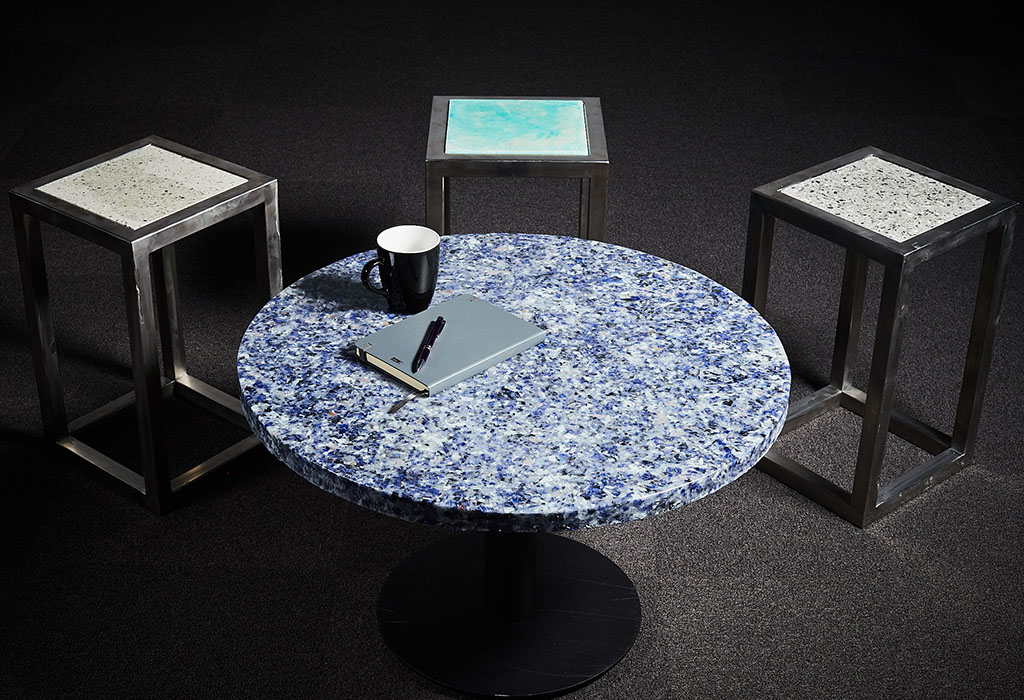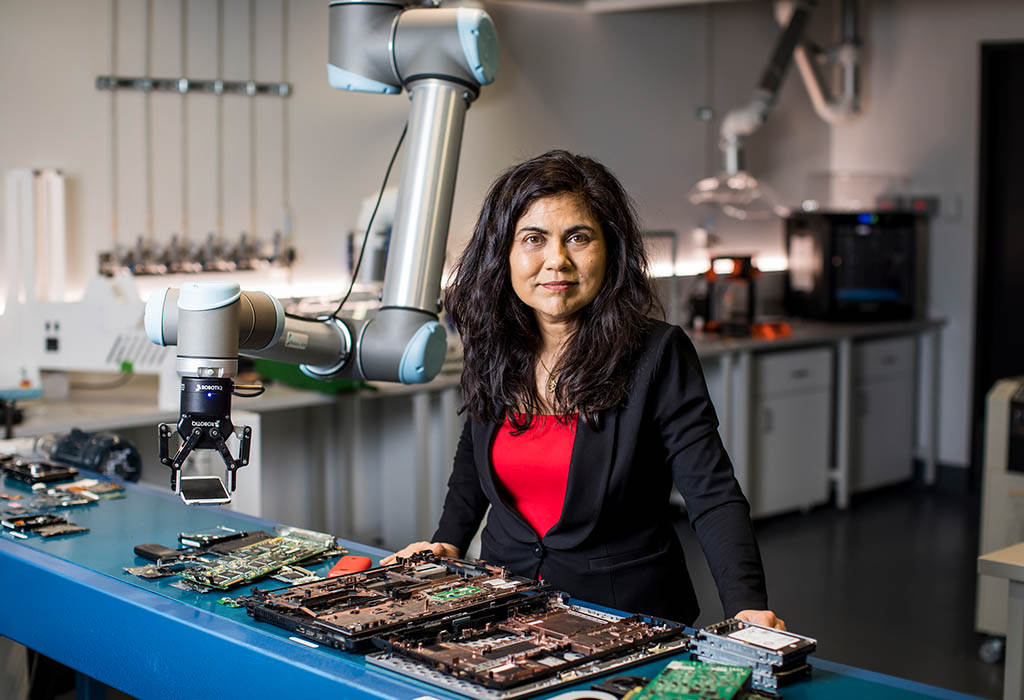Latest news
Read the latest news from the Centre for Sustainable Materials Research and Technology

In the below opinion editorial and video published by the Australian Academy of Science at the end of 2019, Veena explains the national and global context of why we need to develop circular economies and be smarter with our waste, recycling and manufacturing capability for better sustainable (economic, environmental and social) outcomes.
Australia generates 67 million tonnes of waste per year—that’s 2.7 tonnes per person, the weight of approximately two mid-sized cars. Australia has traditionally shipped most of its recyclable waste to China (with smaller amounts shipped to Indonesia, Vietnam, India, Malaysia, and Thailand), in shipping containers that would otherwise return empty to their country of origin.
In 2017, China imposed restrictions on the kinds of waste it would accept and Australia’s export of waste to China decreased 41 per cent, from 1.26 million tonnes to 0.75 million tonnes.
What are we supposed to do with this waste now?
We need to change the way we think about waste—to start treating it as a resource rather than a problem
In August 2019, Australia’s state and federal leaders agreed to set a timeline to ban overseas waste exports, which includes plastic, paper, glass and tyres. The Australian Prime Minister, Scott Morrison, stated that in 2020, 1.4 million tonnes of recyclable material will no longer be exported.
At the General Assembly of the United Nations in September 2019, the Prime Minister emphasised Australia’s efforts to tackle climate change by developing new recycling technologies. The federal and state governments plan to build our national capabilities to reduce, reuse and recycle the goods and products we no longer need into new products, essentially developing a ‘circular economy’ for Australia. To do this, we need to change the way we think about waste—to start treating it as a resource rather than a problem.
A successful circular economy will have financial, environmental and social benefits. For Australians, this will include more local jobs to support recycling and remanufacturing, financial savings on raw materials, reduced emissions from energy to extract virgin resources and transport waste, and a smaller amount of landfill and stockpiled waste both in Australia and overseas. A report by Access Economics estimated that for every 10,000 tonnes of waste recycled, 9.2 full-time equivalent positions are created, in contrast to 2.8 if the same waste was destined for landfill.

Glass waste can be made into ceramic-style tiles at UNSW’s Centre for Sustainable Materials Research and Technology.
The circular economy closes the loop for materials and resources that make up the goods, products and services we use every day. It is very different to our current linear economy, where products are made, used and thrown away at the end of their useful lives. A circular economy has no beginning and no end, so when a product is no longer useful or required for its initial purpose, it is either reused, remanufactured or recycled for use in another product or process.
As a materials engineer, I lead a team at the University of NSW’s Sustainable Materials Research and Technology (SMaRT) Centre. The centre combines scientific discovery with industry and commercial expertise to close the loop by feeding recovered waste materials into other processes. An example is the ‘Green Steel’ project, which uses discarded rubber car tyres to replace some of the coal used in industrial electric arc furnace steel making.
A key ingredient for a successful circular economy is developing technologies that can allow end-of-life products to be broken down into their component materials and reused locally. This saves transport costs and associated emissions, as well as creating employment in Australian cities and regional areas.
One possible solution is the SMaRT Centre’s microfactories: engineered modules that can transform waste materials from a variety of complex sources including electronics, cars, fabric and glass waste. The diversity of possible ‘waste’ input sources means the technology can be used by a broad range of communities and industries. SMaRT Microfactories can be installed in an area of approximately 100 square metres, a stark contrast to the large traditional waste factories. Our idea is to make them accessible and available so that all councils could have on-site SMaRT Microfactories at their transfer station.

Professor Sahajwalla and her team at UNSW have developed microfactories that can engineer materials from discarded glass, plastics, clothing and other waste materials, which can go into making useful everyday items.
Our first SMaRT Microfactory was launched last April at UNSW Sydney and takes electronic waste input from discarded phones, laptops and printers, and turns them into new products such as plastic filaments for 3D printing. Our second ‘green microfactory’ will use many everyday recycled materials that usually go into council bins as feedstock to produce tiles for the built environment. We have plans to develop SMaRT Microfactories that will be able to turn a range of everyday household waste products, such plastics, into commercially viable products.
Left to the market alone, little progress will be made towards achieving a circular economy; capital investment is required. Governments, industry stakeholders, policymakers, the community, and individual consumers need to act to prioritise recycling. A key pillar in the success of SMaRT Microfactories, and ongoing progress towards a circular economy, is the requirement to bring together these traditionally segregated stakeholders to collectively find innovative ways of reprocessing the products we no longer need and giving them a new life.
The circular economy closes the loop for materials and resources that make up the goods, products and services we use every day
Our political leaders said that their strategy to stop waste exports and establish a local circular economy will draw on the best science, research and commercial experience, including research from agencies like CSIRO and our Australian universities. As director of the University of NSW Circular Economy Innovation Network, launched by the NSW Minister for Planning and Public Spaces, Rob Stokes, on 9 October 2019, I envision this network unifying the diverse stakeholders that a circular economy calls for.
Technologies and partnerships such as those developed by the SMaRT Centre provide the production and supply of raw materials recovered from waste as input for future products, but the final piece of the circular economy is to have customers, including manufacturing companies and individual consumers, that are willing to buy the products created. Reframing our perception of ‘waste’ and realising that a no longer useful item is just a step in the process of a circular economy will enable this transition.

Electronic waste (e-waste) contains valuable materials that can be collected and re-formed into materials and products for new uses.
Government initiatives should establish a way for these products to feed back into the production system at the end of their lives—a circular economy loop. Supporting and promoting the establishment of a circular economy is reiterated throughout the National Waste Policy Action Plan 2019. The National Container Deposit Scheme is one such initiative.
To increase consumer confidence, products made from recycled and remanufactured materials will need to meet quality standards that people expect of the goods and products they use every day. When this happens, Australians will support businesses and initiatives that use recovered materials with the expectation that the products are not substandard and are fit for purpose.
The circular economy and its supporting technologies have a range of social, environmental and economic benefits which will help address several of the United Nations Sustainable Development Goals (SDGs), principally SDG 12: responsible consumption and production. My team and I at the SMaRT Centre are expanding our thinking from recycling ‘like as like’ and keeping materials in single industries or businesses—we’re adding onto the environmental mantra ‘reduce, reuse, recycle’, by going beyond recycling to add the fourth ‘R’, re-form.